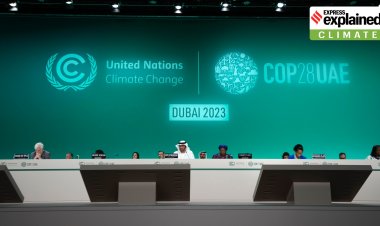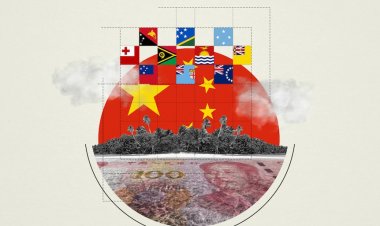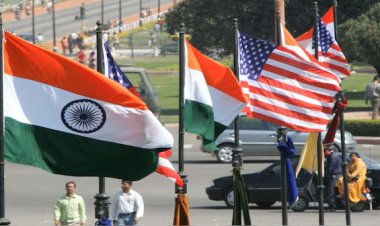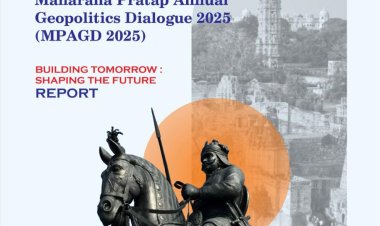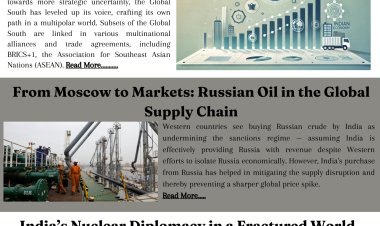India's Looming Catastrophe: The Interlinked Crisis of Land Degradation, Food Security, and National Stability
By connecting the dots between land quality, food, and national stability, The author propose an alternative lens to look at national security that does not turn a blind eye towards the crucial issues of LDD and considers the broader problem of climate change as a security threat, rather than putting it in the sidelines.
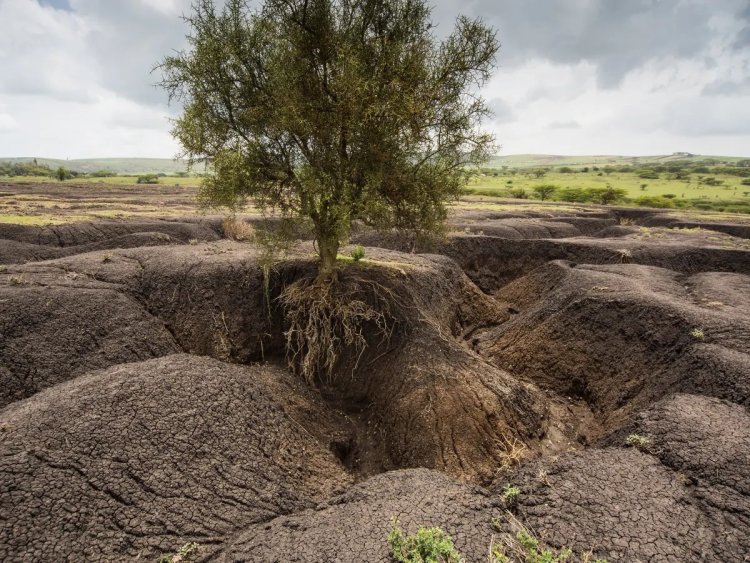
Analysis
By Jayendra Singh
The value of land in international relations is paramount. The notion of having a ‘territory’ through the division of land was the first method of clearly defining political and national boundaries, generating a feeling of belonging to the ‘homeland’. Wars were fought to acquire or safeguard fertile pastures, be it for agricultural or strategic purposes. The importance of land has remained the same, if not grown more throughout the millennia of human existence. The treatment and maintenance of land, however, is one thing that humanity has collectively bartered for economic growth and prosperity. Recent studies in the domain of Land Degradation and Desertification (LDD) shed light on the nonchalant deterioration of land for the ‘growing population’, through excessive deforestation or agriculture. While an issue like this is often categorised as a purely ‘agricultural’ or ‘environmental’ issue, this is precisely the habit that keeps this problem unresolved and out of policy agendas, consequently leaving the land deserted, people unfed and conflict brewing.
By connecting the dots between land quality, food, and national stability, I propose an alternative lens to look at national security that does not turn a blind eye towards the crucial issues of LDD and considers the broader problem of climate change as a security threat, rather than putting it in the sidelines. I argue that simply ‘having’ a piece of land does not translate to national stability, resilience and overall security; maintenance and growth of the land through radical policy reforms. However, while forging these policies, one uncovers the deeper socio-economic problems–such as political corruption, black markets and lackluster governance–that have been hampering our progress all along. This article pitches the idea that the land quality of India is a major tenet in not just food security but its overall domestic security infrastructure. The article also aims to answer the question of whether India’s agrarian policies (specifically related to fertilizers) paired with climate change will be the straw that breaks the camel’s back.
Agriculture, Food Security and Policy
While the contribution of the agriculture sector to the GDP has continued to decline over the years, from 29% in 1990 to 17% in 2016 – it remains a major source of employment, accounting for about 45.5% of the total national workforce- according to NSSO’s latest annual Periodic Labour Force Survey (PLFS) report for 2021-22 (July-June). Therefore, for India, agriculture is still a major source of national stability in terms of economy and especially food security. To sustain and feed its significant populace, it must utilize the arable land it has, which is on a continuous decline.
Based on the desertification and land degradation Atlas of India released by the Indian Space Research Organization (ISRO), around 30% of India’s land is now degraded. While this might sound like a number on the lower scale, it is important to consider that the majority of the degraded land is either rainfed farmland or forest land. More than half of the agricultural land in India is rainfed land, directly responsible for the country’s food security. Therefore, any mismanagement of these pieces of land is bound to severely impact India’s already low food security index, which, if we consider India’s population, means millions are left hungry; leaving the country more vulnerable to conflicts arising in such situations.
According to the Global Food Security Index, there are four major indicators for optimal food security in a nation: Availability; Accessibility; Sustainability and Adaptation; and Quality and Safety. This article concerns itself with two indicators: Availability and Sustainability and Adaptation. Healthy topsoil creates better conditions for crops to grow, providing essential nutrients and ensuring proper yield. Climate change-induced natural disasters and irregular weather patterns have led to excessive loss of soil fertility and nutrients. Moreover, India’s agrarian policies have not been the best motivator for sustainable agriculture till now, promoting excessive fertilizer use and parochial methods of crop production, and ignoring the ground reality of the local political economy of agriculture. This makes the system incredibly fragile and susceptible to fluctuations.
An analysis by Sid Ravinutala of India’s Urea policy from 2016 shows that India has excessively relied on Urea as a ‘golden bullet’ ever since the Green Revolution. India currently subsidizes Urea at a price of Rs. 242 per 45kg bag, which enables farmers to procure it at a reasonable scale. This subsidy–which helps ensure yield and proper supply to farmers–is subject to many externalities, mainly in the form of leakages in terms of supply. High-level farmers with influence in local politics often procure more urea and resell it at a higher price, this black market has been identified as a problem by many researchers including Ravinutala.
Moreover, the subsidy of one particular fertilizer has shifted the NPK ratio of nutrients from the ideal value of 4:2:1 to absurd values like 31.4:8:1 in Punjab. This is caused by excessive use of one fertilizer in the soil, which is Urea. Soil imbalance and reduced yields are common in such unbalanced soil. This type of issue in the long term can cause desertification. This is a cause for concern because India recently approved another subsidy for Urea, albeit this comes with other measures to foster sustainable agriculture, without reforming the urea regime in India the problems are far from gone.
To focus on P and K, the government must invest in some robust awareness programs, but more than that, they must put in the money to help reduce the price of the latter, instead of keeping urea as the silver bullet for fixing food security in India. These policies might seem like a great idea in the beginning to have a bearing on the nation’s overall food security, factor in the lack of proper availability and a fragmented supply chain, and it becomes a chain of problems, especially for the poor farmers who have to bear the brunt of these inefficient policies, leading to increased conflicts between farmers and farmer suicides.
Food security = national security
The connection between agricultural policies and national security seems far-fetched at first, but upon further exploration, it makes sense to see these concepts not as isolated domains but rather as an interconnected mesh where each influences the other, albeit indirectly. Here the main thread that connects the issue of food (in)security with national security are two things, first is India’s specific agricultural policies discussed above, which is one of the many reasons for increased land degradation in India and second is Climate Change and other policies which affect the GFI index in India.
The United Nations has recognized the impact of land quality on a nation’s overall stability, and the rate at which India is currently destroying its land is going to prove itself a major problem that will go beyond the scope of just a ‘climate change’ issue. The problem will become political and societal in nature rather than just being an environmental issue, mostly because the land is central to India’s political economy, and it happens to be the reason for the majority of the conflicts in the world.
Studies have shown that nations with higher levels of conflict experience a rapid decrease in food security, and large-scale events like the Arab Spring were correlated to the food crisis in Tunisia. Moreover, the increased geopolitics of food has become a heated topic as countries begin to feel insecure about their food security. India might not seem like it is at risk of this kind of issue, but the problem is much more complex than that, and should not be seen as an issue which can be solved later.
Climate change has begun showing its true colours now, with increased heat waves, cold waves, and devastating monsoons devouring the city’s water management systems like in Delhi NCR regions. The nation is drowning in extreme weather events. The impact on the agriculture sector will be exacerbated due to the lack of arable land in India.
Moreover, the issue is not just about the provision of food but also about accessibility, and proper infrastructure as explained by Ravinutula. India is currently dealing with conflicts on its borders, especially with China. And in light of recent events in the northeastern states, more conflicts are emerging. A recent study tells us that “harvest loss is robustly associated with increased levels of political violence. To the extent that future climate change will negatively affect local food production and economic activity, it appears that it also has the potential to fuel further fighting in areas that already are scenes of Chronic Conflict” Moreover, many IR and geopolitical experts like Jeffrey Mazo have asserted that climate change is a major form of security threat for nations, even causing internal disturbances.
India is at a critical juncture where the looming threats of land degradation and desertification intersect with its food security and national stability. India must adopt a critical and analytical outlook and acknowledge the profound ramifications of degraded land on its agriculture and social fabric. A comprehensive and holistic approach is essential, prioritizing sustainable land use policies, balanced fertilizer utilization, and proactive environmental practices. By recognizing the inextricable link between land degradation and national security, India can pave the way for a resilient and prosperous future, safeguarding its people from hunger, conflicts, and instability. The time to act is now, and India must rise to the challenge of securing its land and ensuring a sustainable future.
Disclaimer: This paper is the author's individual scholastic contribution and does not necessarily reflect the organization's viewpoint.
Jayendra Singh is a Final year student at the Jindal School of International Affairs pursuing MA in Diplomacy, Law and Business. His research interests lie in the field of Global Environmental Governance, Green (IR), and caste studies.


